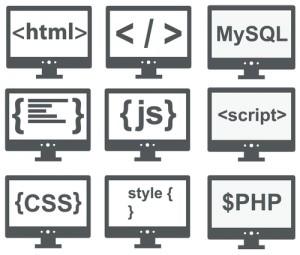
Learning how to code may be the best way to secure your or your children’s financial future. “By 2020, U.S. universities will not be able to fill even a third of the country’s 1.4 million computing positions with qualified graduates,” said a recent Time article. Learning to code translates into guaranteed job offers, then.
The good news is that learning computer programming no longer requires advanced study in a classroom. Today, there are so many free resources available to anyone with an Internet connection – or public library access – that even young children can learn computer science! Don’t wait for public schools to catch up – 9 out of 10 schools do NOT teach computer science!
8 free ways to learn to code (for you and your kids!)
1. CodeAcademy.com
Ages: teens and up
Classes in: HTML, CSS, Javascipt, PHP, Ruby, Python, jQuery, APIs.
If you’ve never seen a line of HTML, this is the place to start. Code Academy has 7 basic online classes that move slowly and explain everything in great detail. Their online lessons are broken up into teeny tiny steps, so you feel you are constantly moving foward – and satisfied that you are making progress.
The site also remembers where you left off, so it’s easy to do a 10-minute lesson, grab a snack, and come back exactly where you left off. You can also very easily go back and review past lessons if you need a refresher. The site is very intuitive and doesn’t take a lot of time to navigate so you can pretty much just dive right in.
I took the basic HTML/CSS class and loved it. I never had any formal coding training before taking this course, and it was just what I needed. Super easy steps, with everything explained, and hints if you can’t figure it out. I highly recommend CodeAcademy for anyone interested in learning computer programming.
2. Hopscotch for iPad
Ages: 9-11
This iPad app is designed to teach young children the basics of programming. Kids drag and drop bits of code to make games, stories, animations, interactive art, and more. Here is the Hopscotch website and here’s where you can download the app on iTunes. The Hopscotch app is free. Unfortunately, there is no version for smart phones, perhaps because the screens are too small.
3. KhanAcademy.org
Ages: 5+ site wide, older for programming courses
Classes in: Hundreds of tutorial videos, plus classes in Javascript, Cryptography, Information Theory.
Computing science is just one subject covered by Khan Academy, which teaches math, art history, economics, and test prep, among other subjects. In the computer science arena, it focuses on Javascript and also has a course on Cryptography and Information Theory. The site is not as streamlined as CodeAcademy, but that is partly because of the wealth of information available on the site – all for free!
Khan Academy is also a great site for junior high school and high school students looking for a tutor or explanations about anything they are studying or interested in. Algebra, history, English…it’s all there in easy to understand video tutorials.
4. Code.org
Ages: 4+
Teaches: basic programming concepts, Javascript, Python
Funded by tech giants Bill Gates, Mark Zuckerberg, Amazon.com and Google, Code.org is on a mission to teach children computer science AND get programming into public school curriculums across the country. The site uses drag and drop programming for youngsters in “game-like, self-directed” tutorial video lectures. One example for kids is called Plants vs. Zombies. One major bonus is that the site is available in 34 languages.
Bonus: The NYTimes wrote a story in May 2014 about Code.org: “The organization pays to train high school teachers to offer more advanced curriculums, and, for younger students, it has developed a coding curriculum that marries basic instruction with video games involving Angry Birds and hungry zombies.”
Code.org runs the Computer Science Education Week and Hour of Code, two initiatives that aim to get more youngsters comfortable coding. Sign a petition that says you believe every student should have the opportunity to learn computer programming, and see how you can get involved. This year’s computer science education week is Dec. 8-14, 2014.
5. GirlsWhoCode.com
Ages: Female high schoolers
Teaches: Basic to intermediate programming skills during a summer camp program for girls.
Just .3% of girls chose computer science as a major in college. Very few end up as software engineers. Girls Who Code is out to change that. The site runs a 7-week summer camp immersion program in select cities across the country for sophomore and junior level girls. The program is free and scholarships for transportation are available.
Campers study programming from 9-4, plus take field trips to Google, Facebook, Twitter, AT&T, Gilt Groupe, Foursquare, and the News Corp. They also meet female entrepreneurs, CEOs, developers, designers, and computer science majors who function as mentors.
There are also Code Clubs if you are not near an immersion program. The clubs are a bit broader, accepting grades 6-12. A group of 15 girls are required to establish a new club, which are supported by the organization with monthly, project based activities.
6. Computer Science via Harvard University
Ages: adult or advanced teen
Teaches: Extensive programming in C, PHP, and JavaScript.
Tune into computer science lectures taught as an extension class at Harvard University. There are 2 hour-long videos each week; the course is 13 weeks long. You can listen in three different formats: Quicktime, MP3, or Flash. Taught by David Malan, PhD.
The course covers “algorithms (their design, implementation, and analysis); software development (abstraction, encapsulation, data structures, debugging, and testing); architecture of computers (low-level data representation and instruction processing); computer systems (programming languages, compilers, operating systems, and databases); and computers in the real world (networks, websites, security, forensics, and cryptography). The course teaches students how to think more carefully and how to solve problems more effectively.”
Start the Harvard computer science course here.
7. Massive Open Online Courses
Age: adults
Teaches: no classes offered directly through this site, which aggregates provides of free online classes.
There are many, many more free computer science classes available online (as well as for hundreds of other topics), also called massive open online courses. (Massive, because hundreds of thousands of people are taking them. Open, because they are free. I think you get the rest.) One site that aggregates all the MOOCs available is MOOC-list.com.
Search for courses by category, university, instructor, country, language, type of certificate. Note, MOOCs typically do not offer college credit, but you may be able to earn a certificate. Contact the entity that offers the course for details. Read reviews of past courses. See the course work required. Watch videos. The site is free to use and there are a lot ads to support it – so be wary where you click.
8. Kode with Klossy
Founded my supermodel Karlie Kloss, Kode with Klossy is a free two-week coding camp for girls aged 13-18. The program uses the Flatiron School’s web development curriculum and is taught using the Learn.co platform. Girls are introduced to software engineering principles and learn the same programming languages behind apps like Twitter and The New York Times. The camps take place in three cities this year: St. Louis, New York, and Los Angeles.
Do you code? What programming sites do you like?


I code in ADA and in C++. I am taking interactive java programming classes at:
http://www.oreillyschool.com/
If you are interested in learning about the factors affecting the price of bitcoin, I recommend reading an informative article on this Link. This provides valuable information about how the bitcoin price is determined and can help you navigate the market more effectively. I think it will be interesting for you. Have fun reading, and I hope this resource will be useful for you. Have a good day!
Web developers often face some programming problems. As a programmer, overcoming these hurdles is vital. Seeking assistance, especially like artificial intelligence assignment help very helpful. This kind of resource for developers help them navigating the ever-evolving landscape of programming.